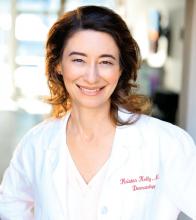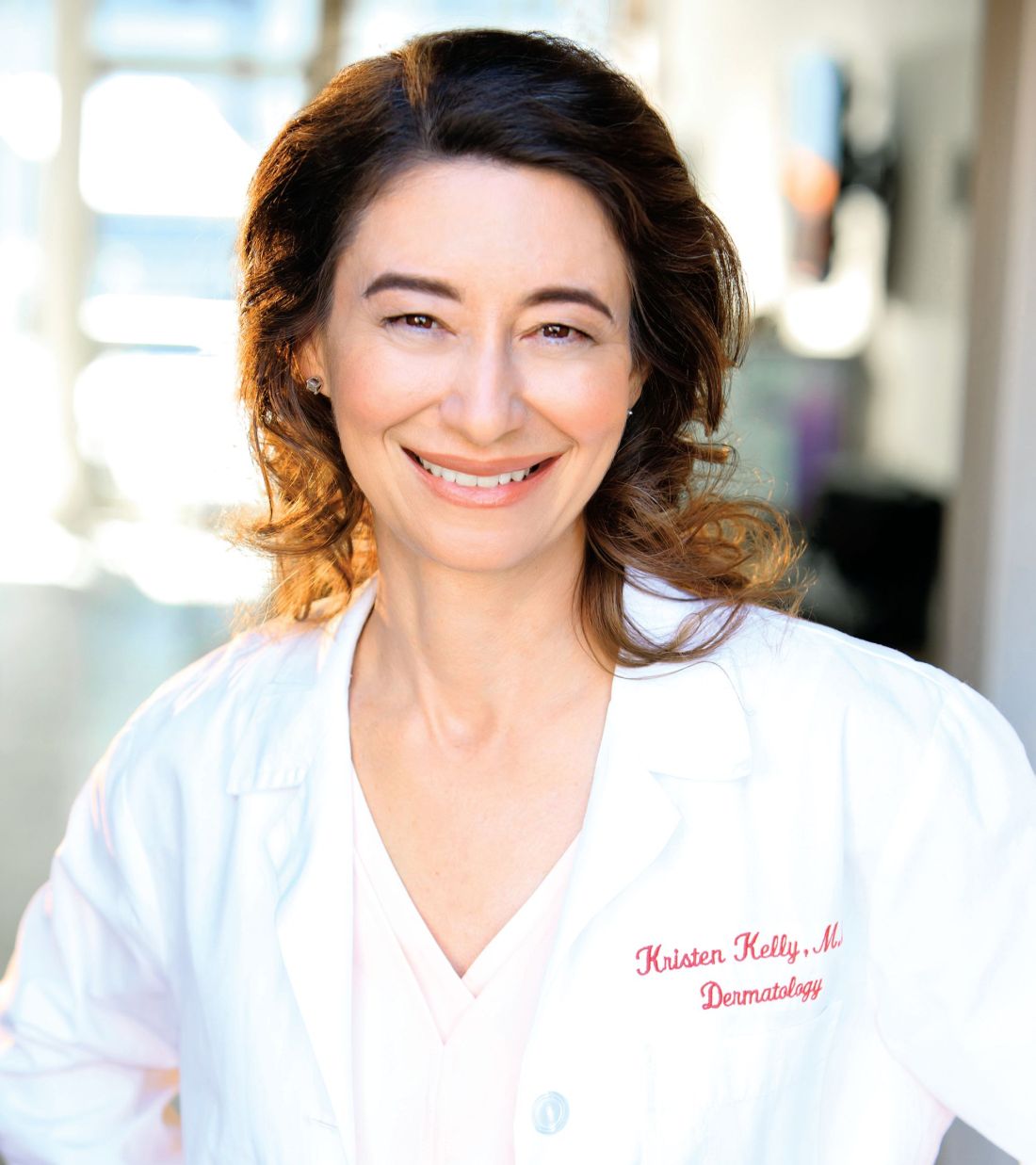User login
Current treatment with available light-based devices, notably ablative fractional resurfacing, can greatly improve quality of life for patients struggling with scars, according to Kristen Kelly, MD, of the University of California, Irvine.
Using multiple devices, and combining devices with other therapies, are among the strategies that can improve pain and function in these patients, she said in a presentation at Skin Disease Education Foundation’s annual Las Vegas Dermatology Seminar.
Dr. Kelly recommends “a CO2 laser or an Er:YAG [erbium-doped YAG],” as AFR options for scar treatment. The Er:YAG is less painful, but may cause bleeding, she noted.
Tips for a scar treatment protocol with AFR include low density and treating the entire scar plus a 1-2 mm rim, Dr. Kelly said. AFR treatment of scars can start in some cases soon after an injury, but it depends on the cause of the scar and treatment timing is controversial, especially for burn scars, she said. Dr. Kelly outlined a plan of treatment every 2-3 months, with the option of adding triamcinolone suspension immediately after the AFR treatment, she noted.
Other medications used after AFR to improve results include 5-fluorouracil, bimatoprost, and poly-L-lactic acid. However, “you should only consider this for medications that you would safely inject into the skin or bloodstream,” she emphasized.
Combining AFR with other devices can improve results, depending on the type of scar, said Dr. Kelly. Atrophic scars may be treated with AFR or NAFR, while red atrophic scars may improve with a combination AFR or NAFR and a pulsed dye laser, she said. For red hypertrophic scars, consider a combination of AFR plus a steroid combined with a pulsed dye laser, she added.
When embarking on a scar treatment plan, be sure to define goals and remind patients that scars can be “improved but not removed,” said Dr. Kelly. “Laser therapy is often not monotherapy,” she added. A surgical revision, such as a Z-plasty, and the use of physical and occupational therapy also can improve results and improve quality of life for patients, she said.
Dr. Kelly disclosed relationships with multiple companies including Allergan, MundiPharma, Syneron Candela, Light Sciences Oncology, Novartis, Sciton, and ThermiRF.
SDEF and this news organization are owned by the same parent company.
Current treatment with available light-based devices, notably ablative fractional resurfacing, can greatly improve quality of life for patients struggling with scars, according to Kristen Kelly, MD, of the University of California, Irvine.
Using multiple devices, and combining devices with other therapies, are among the strategies that can improve pain and function in these patients, she said in a presentation at Skin Disease Education Foundation’s annual Las Vegas Dermatology Seminar.
Dr. Kelly recommends “a CO2 laser or an Er:YAG [erbium-doped YAG],” as AFR options for scar treatment. The Er:YAG is less painful, but may cause bleeding, she noted.
Tips for a scar treatment protocol with AFR include low density and treating the entire scar plus a 1-2 mm rim, Dr. Kelly said. AFR treatment of scars can start in some cases soon after an injury, but it depends on the cause of the scar and treatment timing is controversial, especially for burn scars, she said. Dr. Kelly outlined a plan of treatment every 2-3 months, with the option of adding triamcinolone suspension immediately after the AFR treatment, she noted.
Other medications used after AFR to improve results include 5-fluorouracil, bimatoprost, and poly-L-lactic acid. However, “you should only consider this for medications that you would safely inject into the skin or bloodstream,” she emphasized.
Combining AFR with other devices can improve results, depending on the type of scar, said Dr. Kelly. Atrophic scars may be treated with AFR or NAFR, while red atrophic scars may improve with a combination AFR or NAFR and a pulsed dye laser, she said. For red hypertrophic scars, consider a combination of AFR plus a steroid combined with a pulsed dye laser, she added.
When embarking on a scar treatment plan, be sure to define goals and remind patients that scars can be “improved but not removed,” said Dr. Kelly. “Laser therapy is often not monotherapy,” she added. A surgical revision, such as a Z-plasty, and the use of physical and occupational therapy also can improve results and improve quality of life for patients, she said.
Dr. Kelly disclosed relationships with multiple companies including Allergan, MundiPharma, Syneron Candela, Light Sciences Oncology, Novartis, Sciton, and ThermiRF.
SDEF and this news organization are owned by the same parent company.
Current treatment with available light-based devices, notably ablative fractional resurfacing, can greatly improve quality of life for patients struggling with scars, according to Kristen Kelly, MD, of the University of California, Irvine.
Using multiple devices, and combining devices with other therapies, are among the strategies that can improve pain and function in these patients, she said in a presentation at Skin Disease Education Foundation’s annual Las Vegas Dermatology Seminar.
Dr. Kelly recommends “a CO2 laser or an Er:YAG [erbium-doped YAG],” as AFR options for scar treatment. The Er:YAG is less painful, but may cause bleeding, she noted.
Tips for a scar treatment protocol with AFR include low density and treating the entire scar plus a 1-2 mm rim, Dr. Kelly said. AFR treatment of scars can start in some cases soon after an injury, but it depends on the cause of the scar and treatment timing is controversial, especially for burn scars, she said. Dr. Kelly outlined a plan of treatment every 2-3 months, with the option of adding triamcinolone suspension immediately after the AFR treatment, she noted.
Other medications used after AFR to improve results include 5-fluorouracil, bimatoprost, and poly-L-lactic acid. However, “you should only consider this for medications that you would safely inject into the skin or bloodstream,” she emphasized.
Combining AFR with other devices can improve results, depending on the type of scar, said Dr. Kelly. Atrophic scars may be treated with AFR or NAFR, while red atrophic scars may improve with a combination AFR or NAFR and a pulsed dye laser, she said. For red hypertrophic scars, consider a combination of AFR plus a steroid combined with a pulsed dye laser, she added.
When embarking on a scar treatment plan, be sure to define goals and remind patients that scars can be “improved but not removed,” said Dr. Kelly. “Laser therapy is often not monotherapy,” she added. A surgical revision, such as a Z-plasty, and the use of physical and occupational therapy also can improve results and improve quality of life for patients, she said.
Dr. Kelly disclosed relationships with multiple companies including Allergan, MundiPharma, Syneron Candela, Light Sciences Oncology, Novartis, Sciton, and ThermiRF.
SDEF and this news organization are owned by the same parent company.
EXPERT ANALYSIS FROM SDEF LAS VEGAS DERMATOLOGY SEMINAR

